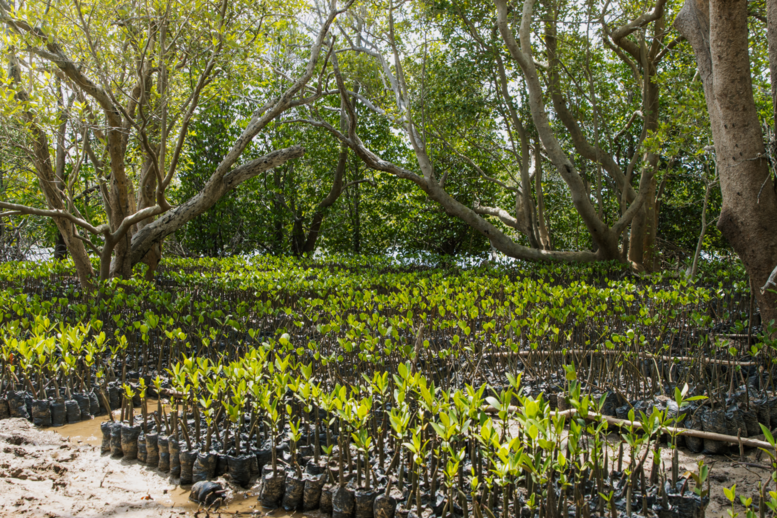
Mangroves: Nature’s biodiversity champions under threat
On 26 September, World Environmental Health Day reminds us that restoring ecosystems is vital. Mangrove forests play a crucial role in keeping coastal and marine environments healthy and resilient. Yet, despite supporting extraordinary wildlife diversity, these unique ecosystems are facing unprecedented threats from development, deforestation, and climate change worldwide.
Found along tropical and subtropical coasts, mangroves thrive where freshwater and seawater meet, forming dense and vital forests. These are sprawling underwater cities, their distinctive prop root systems creating intricate mazes that shelter some of the planet’s most diverse marine communities. Over 1,500 species call these ecosystems home, from microscopic organisms to large marine mammals.
The structural complexity of mangroves supports remarkable biodiversity across multiple habitat zones. In the canopy, different bird species nest and feed, including kingfishers, herons and endemic mangrove warblers. Proboscis monkeys navigate the branches in Southeast Asia, while West Indian manatees graze peacefully in Caribbean mangrove channels.
Below the waterline, the real magic happens. Juvenile fish, crabs and shrimp develop in the protective root corridors before venturing into open waters. Over 80 per cent of global fish catches depend on healthy coastal ecosystems, with mangroves serving as critical nurseries for species that eventually populate coral reefs and offshore fishing grounds. Young sharks, rays and countless fish species find both food and protection in these natural, nutrient-rich sanctuaries.
Despite their ecological importance, mangrove forests face severe threats. Coastal development has eliminated 35 per cent of global mangrove coverage over the past two decades, with remaining forests fragmenting into isolated patches unable to maintain their full biodiversity. Climate change compounds these pressures through rising sea levels, altered rainfall patterns and intensifying storms.
The resultant biodiversity loss cascades through the entire food chain. When mangroves disappear, fish populations crash, migratory bird routes become disrupted, and marine ecosystems lose their natural water filtration systems. Coastal communities dependent on fishing and eco-tourism suffer immediate economic impacts while the broader marine environment loses critical habitat connectivity.
One of the coastlines that most exemplifies the urgent global challenge facing mangrove ecosystems is in Kenya. Decades of coastal development and climate pressures have severely degraded these vital habitats, threatening both marine biodiversity and the livelihoods of over 700,000 people dependent on coastal fisheries. Responding to this crisis, global outdoor power equipment leader Husqvarna has partnered with environmental organisations veritree and EarthLungs for the ambitious Kenyan Mangrove Restoration Project. This collaborative initiative aims to plant over 500,000 mangrove trees along damaged coastlines. Progressing well, these projects are creating a scalable model for ecosystem restoration that directly benefits marine wildlife while providing sustainable economic opportunities for local communities.
Working with coastal inhabitants, the project provides employment while building local capacity for long-term forest stewardship. Community members receive training in seedling cultivation, planting techniques and ecosystem monitoring, creating income sources while protecting restored areas from future degradation.
The partnership also uses advanced monitoring technology to track restoration success, ensuring planted mangroves survive and develop into mature forests capable of supporting full biodiversity. This data-driven approach maximises conservation impact while providing accountability to stakeholders.
The project’s success extends far beyond Kenya’s coastline, however, creating a proven framework for global environmental action. By combining corporate resources with cutting-edge monitoring technology and local expertise, the partnership demonstrates how strategic collaboration can accelerate ecosystem restoration at scale.
“The restoration of mangrove forests represents more than conservation. It embodies a fundamental shift toward recognising nature as our greatest ally in addressing the interconnected crises of biodiversity loss, climate change, and social inequality,” says Jonas Willaredt, vice-president of Sustainability Affairs, Strategy & Business Development at Husqvarna Forest & Garden.
World Environmental Health Day reminds us that human well-being and environmental health are inseparable. Initiatives to restore mangrove ecosystems not only safeguard biodiversity but also strengthen climate resilience and support local livelihoods.
This approach offers a blueprint for similar efforts worldwide – demonstrating that investing in biodiversity and ecosystem health is ultimately an investment in our own survival and prosperity.
Progress on the Kenyan Mangrove Restoration Projects can be tracked through veritree’s transparent monitoring system at https://impact.veritree.com/husqvarna.
And for more information about Husqvarna’s sustainability initiatives, visit https://www.husqvarnagroup.com/en/sustainability



